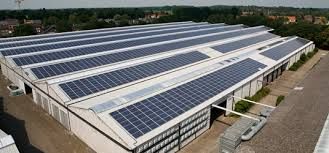The scorching pace of solar power – V
This is the last article in a five part series. The other articles can be found at Part I: http://asiaconverge.com/2016/04/is-fear-of-bankruptcy-forcing-oil-rich-saudi-turn-to-solar-power-wait-for-25-april-html/ Part II: http://asiaconverge.com/2016/04/crashing-prices-india-can-gain-immensely-solar-power-space/ Part III: http://asiaconverge.com/2016/04/india-tremendous-advantage-solar-power-space-money/ Part IV: http://asiaconverge.com/2016/04/india-not-learn-germanys-hermann-scheer-solar-power-model/
India had every reason to do better than Germany. It has more sunshine. It has been gifted with a population of 1.25 billion.
Using a rough figure of 5 people to a family, that means 205 million households. Discount half of these, to take care of poor families which do not have a roof over their heads, or those who stay in joint families, or in areas where the sun does not reach at all (as in forests). Even then 100 million households is a large number. One giga watt (GW) is 1 million kilo Watts (kW). Even if each house could generate around 100 kW, it would meet the national target of 100 GW almost overnight.
And rooftop solar could be harnessed not only from residential areas, but also from commercial complexes, and the rooftops of factories which occupy huge swathes of land.
Instead of blocking huge tracts of land for solar power, permitting each building to generate its own solar power would be a better solution. If proper policies are introduced which allow people to first generate power at zero cost, and then actually earn money from selling that power to the state, citizens are bound to welcome such a scheme. It would reduce the country’s import of oil, provide employment, and improve the environment.
If Germany found that the solar industry employs more people than the auto sector, India should have been rooting for this concept from the word “go”.
Of course, critical to this is the creation of a layer of people who can be agent-aggregators. Their job is to ensure that the solar panels are working, and to promptly report any damage to them. Since each household would generate minuscule amounts of power, these agent-aggregators would aggregate the power, clean up the variances, and sell it to the grid. They would earn money provided they could aggregate and sell the power to the grid.
What India’s policymakers need to realise is that this is a labour intensive operation. Germany discovered that — after 8 years — the solar industry employed more people than did the auto industry. Obviously, especially for India, the employment generation potential of this scheme is mind-boggling, especially because it has so many unemployed youth. Scheer ensured that each agent was trained to cope with the basics of installation and maintenance. He got them to understand how bi-directional meters work.
India stands to benefit even more than Germany primarily because it has are more buildings per square kilometer than in most countries in the world.
Moreover, with land being scarce, the rooftop suddenly begins to assume both economic and national significance.
Decentralised cluster power generation
This works even better when it comes to far flung villages. Typically, the cost of supplying power to far flung areas with scant populations, can be prohibitively high. Thus, while it may cost a few hundred rupees to provide connection to a house in a city like Mumbai, it could cost the state several tens of thousands rupees to lay transmission lines to a lone house on the top of a hill. After all, the state is mandated to provide electricity to everyone, irrespective of where the person stays.
With solar, you can have distributed cluster power stations. A solar panel can supply power to say 10 huts. The installation is done by an entrepreneur who also acts as agent-aggregator. He provides the electricity to the huts in the village, and gets paid by the state for doing so. If the house uses more power than it is allowed, it would have to pay the required tariff.
Since the distance between the power generating solar panels and the huts is not large, there is little scope for theft of power. It would reduce transmission costs. It would prevent electricity theft, which is often mis-classified as agricultural power in India.
How would this get financed?
Simple. Take the amount of subsidy the state provides to the target group. Multiply the subsidy into the number of householdes and then multiply this by 15-20 years. You then get the total subsidy that will be spent in say 15-20 years. Capitalise that. Lend out this money to shortlisted entrepreneurs who are willing to provide the right financial and performance guarantees. Use that money to finance the agent-aggregators. Suddenly, you will find these entrepreneurs arranging for the rest of the money from private financiers too, as they now have a revenue stream guaranteed by the state.
Why is this not being done?
There are three reasons why this is not being done.
One is the short-sightedness of policymakers. Elected representatives generally have a 5 year time horizon for implementing schemes. Bureaucrats have a 20-year time frame. Such a policy requires a financial and legal framework that must survive for 50 years, and not be buffeted by idiosyncratic policies, caprice, or expedient strategies. India’s policymakers do not appear to have the willingness to do this.
Second, there is a vested interest that politicians and land grabbers have in subverting the rooftop solar scheme. The beauty of the rooftop solar scheme is that it requires no land. Hence there are no land acquisition costs. Since the power lines between the power generation panels and the consumers is a very short one, there are hardly any transmission charges either.
Plain logic should tell you that this is more economical than large solar farms where land is acquired and given to an entrepreneur. In a country that is starved of land, this does not make sense. In the rooftop solar scheme, every household becomes a power generator. Every household has the potential to earn from this power. And there is little possibility of theft.
Third, and the most serious is that the existing setup has huge vested interests in the power subsidy regime. The FIT scheme dovetailed with rooftop solar power eliminates the possibility of power theft. That puts paid to several thousand mini steel producers who use the electric arc furnace route through power theft. It destroys the ability of rural manufacturing units promoted and p[rotected by politicians. Till these are tackled, there will be tremendous reluctance to adopt and promote the rooftop solar scheme.
Consider this. If I can generate solar power at Rs.4/kWh, why would I use state power which sells for Rs.6-7/kWh? The same logic holds true for industry. If he can generate solar power from his factory rooftop at Rs.4/kWh, why would be pay anywhere between Rs.8-12?
The moment these people stop purchasing expensive state supplied power, there is no additional money to subsidise power for key votebanks of farmers and slums. The state would be required to provide a separate budget for such subsidies. More importantly, the grease money that the system collects for permitting theft and losses, would also disappear. Obviously, the system would not like to kill its own revenue source, even if it is greasy and yucky.
It is through these indirections that a country is made to lose its way. And what could have been a strategic advantage becomes a colossal disadvantage. And then you hear the full-throated cry of “Mera Bharat Mahan”. All you can do at such times is to shake your head cynically. Nothing more.
(This is the fifth and concluding part of this series)












































COMMENTS